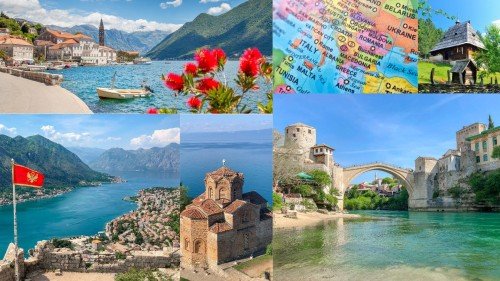
The Balkans is a region in Southeast Europe that comprises several countries, including Albania, Bosnia and Herzegovina, Bulgaria, Croatia, Greece, Kosovo, Montenegro, North Macedonia, Romania, Serbia, and Slovenia. These countries have their distinct languages, but they share a common linguistic heritage known as the Balcan languages.
The history of Balkan languages is a complex and fascinating one that reflects the region's diverse linguistic and cultural heritage.
The Balkan region has been inhabited by various peoples throughout history, including the Illyrians, Thracians, Greeks, Romans, and Slavs, among others. Each of these peoples brought their own languages and cultural traditions to the region, and over time, these languages and cultures interacted and influenced each other.
The earliest known language spoken in the Balkans was Illyrian, which was spoken in the western part of the region before the arrival of the Slavs in the 6th and 7th centuries AD. The Slavs, who came from the east, brought their own language, which evolved into the various Slavic languages spoken in the Balkans today.
During the medieval period, the Balkans was a crossroads of different cultures and civilizations, and this had a significant impact on the development of the region's languages. The Byzantine Empire, which controlled much of the Balkans during this time, introduced the Greek language and culture to the region, which had a significant impact on the development of the Balcan languages.
In the 14th and 15th centuries, the Ottoman Empire conquered much of the Balkans, and Turkish became the dominant language in the region. The Turkish language had a significant impact on the development of the Balkan languages, particularly on the vocabulary and grammar of Bulgarian, Serbian, and Romanian.
In the 19th century, the Balkans underwent a period of nationalist and linguistic revival, which saw the emergence of new national identities and the standardization of national languages. The Balkan Wars of the early 20th century further shaped the linguistic and cultural landscape of the region.
Today, the Balkan languages continue to evolve and adapt to changing social, political, and economic circumstances. While the Balcan languages share many linguistic and cultural features, each language has its own distinct characteristics and history, reflecting the region's rich linguistic and cultural diversity.
The Balcan languages are a group of languages that are part of the larger Indo-European language family. They are spoken by over 60 million people in the Balkan region and other parts of Europe. The Balcan languages have a complex history that is shaped by the region's political and cultural diversity.
The Balcan languages can be divided into three main subgroups: the Eastern Balcan languages, the Western Balcan languages, and the Southern Balcan languages. The Eastern Balcan languages include Bulgarian, Macedonian, and Serbian. The Western Balcan languages include Albanian, Bosnian, Croatian, and Slovenian. The Southern Balcan languages include Greek and Romanian.
The Eastern Balcan languages are characterized by their use of the Cyrillic alphabet, which is derived from the Glagolitic script developed by the medieval Slavic monks. Bulgarian and Macedonian are very similar, and some linguists consider them to be dialects of the same language. Serbian, on the other hand, has a closer relationship with the Western Balcan languages.
The Western Balcan languages are characterized by their use of the Latin alphabet, which was introduced by the Romans in the region. Albanian is the only language in the Balcan region that is not an Indo-European language. It has its linguistic roots in the ancient Illyrian language, which was spoken in the region before the arrival of the Slavs.
Serbian is a South Slavic language that is primarily spoken in Serbia, but it is also spoken by the Serbian diaspora around the world. Serbian is written using the Cyrillic alphabet, which was introduced in the 9th century by the Byzantine Empire and adapted to the Slavic languages by the medieval Slavic monks.
Serbian has many similarities with other Slavic languages, such as Croatian, Bosnian, and Macedonian, and they are often mutually intelligible. However, Serbian has its distinct characteristics that set it apart from other Slavic languages.
One of the most significant features of Serbian is its use of two alphabets - the Cyrillic and Latin alphabets. The use of the Cyrillic alphabet is more common in Serbia, while the Latin alphabet is more prevalent in the diaspora and in certain regions of Serbia. Both alphabets are considered official scripts, and they are used interchangeably in daily communication, media, and official documents.
Serbian has a complex system of grammar, with seven cases and three genders. The language has a rich vocabulary, and it has borrowed words from various languages throughout history, including Turkish, German, and Russian.
Serbian literature has a rich history that dates back to the Middle Ages, and it includes many significant literary works in both poetry and prose. One of the most famous Serbian writers is Ivo Andric, who won the Nobel Prize in Literature in 1961 for his novels that explore the complex history and culture of the Balkan region.
In conclusion, Serbian is a unique and complex language that is an essential part of the cultural heritage of the Balkan region. Its use of two alphabets, rich vocabulary, and complex grammar make it an exciting language to learn and explore. Serbian literature is a testament to the language's richness and cultural significance, and it has influenced many writers and thinkers throughout history.
The Southern Balcan languages are characterized by their use of the Greek alphabet in the case of Greek and the Latin alphabet in the case of Romanian. Greek is one of the oldest languages in the world and has had a significant influence on the development of the Balcan languages.
The Balcan languages have been shaped by various linguistic, cultural, and historical influences. The Slavic languages, for example, were heavily influenced by the Church Slavonic language, which was used in liturgy and religious texts. The Turkish language also had a significant impact on the Balcan languages, particularly on the vocabulary and grammar of Bulgarian, Serbian, and Romanian.
In conclusion, the Balcan languages are a diverse group of languages with a complex history and cultural heritage. Despite their linguistic differences, they share many commonalities and have shaped each other's development over the years. The Balcan languages are an essential part of the cultural heritage of the Balkan region and a testament to the region's rich linguistic and cultural diversity.
Recent Posts

Understanding Translation Serv...

Agenzia di Traduzione a Roma: ...

Die Essentielle Rolle von Übe...

Die Essentielle Rolle von Übe...

Die Essentielle Rolle von Übe...

La Traduction Assermentée: Un...
Share it.
© Copyright 2022 LLC


